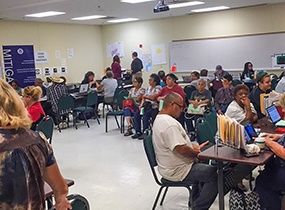DWC employees provide hurricane help
When Hurricane Harvey devastated the Houston area two months
ago, DWC employees around the state responded rapidly. DWC increased staffing
on the Customer Service line, created a resources web page, and reminded insurance
carriers about their responsibilities to injured employees after a disaster.
DWC’s Houston field offices saw multiple closures due to power
outages and minor water leaks. Erica DeLaCruz, assistant director, Field
Operations Management, said field office employees did a tremendous job keeping
a positive attitude, and kept their focus on helping injured employees.
“Several Houston-area staff volunteered at local shelters
and donated money and items,” DeLaCruz said, “even when they and their families
suffered damage.”
Regional managers said many employees had to be evacuated
before, during, and after the hurricane. Some stayed in shelters, others with
friends and family. Two employees lost their homes, and others had to stay in
hotels or RVs.
Many DWC employees also helped coordinate relief efforts and
organized donation drives. And 10 DWC employees went the extra mile—heading
straight to the hurricane-stricken areas to help first hand.
Heading to the coast
Melissa Hield, TDI’s associate commissioner for Consumer Protection, said TDI coordinated
several teams of volunteers—63 in all—from TDI and DWC between August 31 and
October 23.
DWC’s Pat Crawford, a return to work specialist in Health
Care Management, made two trips as a volunteer to areas near Pasadena and
across the coast in September and October.
“We provided an absolutely necessary service,” Crawford
said. “People really did not know what to do. It’s one of the most satisfying
things I’ve ever done.”
Crawford said TDI volunteers went where the people were,
passing out customer service information and answering questions.
“There were 10,000 to 12,000 people in a line for emergency
food stamps,” she said. “It went around the building and down the street. We’d
walk up and down the line asking if anyone had insurance questions.”
The most common questions were what to do if you didn’t have
insurance, and what to do if your insurance adjuster said the damage wasn’t
covered.
“We basically told victims that if they had no insurance,
they needed to go to FEMA for help,” Crawford said. “If they did have
insurance, and were denied, we gave them a letter they could take to FEMA to
get help.”
Whatever they can

Photo: Amy Rich, ready to help hurricane victims at the Port
Lavaca Disaster Recovery Center in the Calhoun County Library.
Amy Rich, communications specialist, Health Care Quality Review, also volunteered, spending five days near the coast.
“You really empathize with the victims,” Rich said. “We’d
see families with crying kids, and we’d give them a coloring book so we could help
their parents with insurance questions.”
Rich said the most memorable moments were helping people
whose apartments had been destroyed, and who had been told they did not have
renter’s insurance.
“One nursing student
was just barely getting by to begin with,” Rich said. “Then her rent money ran out
and she was evicted. She’d been living out of her car. It’s kind of a helpless
feeling, but I’m thankful we had the whole TDI team—the rain ombudsman, the
consumer protection lines—they were all a huge help.”
|

Photo: Hurricane victims get help and information at the Victoria Disaster Recovery Center in the Pattie Dodson Public Health Center.
Volunteers did whatever they could to help in the
hardest-hit areas, Crawford said.
“One day I helped pass out water, another day we passed out
truckloads of bananas,” she said. “Everybody was very thankful—they thanked us
profusely.”
Crawford said it’s difficult to imagine the level of
devastation. Trash collection was running behind, and there were overflowing dumpsters
and empty water bottles everywhere. Piles of debris lined the curbs. Many small
businesses were ruined, and a lot of people were out of work as a result, she
said.
|

Photo: Damage in Refugio, Texas.
Jennifer Hopens, director of DWC’s Appeals Panel Division,
also volunteered, as she had done after Hurricane Ike in 2008. After Harvey,
she spent time in a number of FEMA disaster recovery centers in the Houston
area, and said the residents’ optimism and compassion were inspirational.
“We encountered people who had lost much in the wake of the
storm,” Hopens said, “but they maintained a positive outlook on life, hope for
the future, and concern for others.”
Crawford said the 12-hour days were long, but rewarding. And
while TDI and DWC volunteer efforts have ended for now, it’s still early in the
clean-up and recovery process for the coast.
“My advice to anyone thinking of going to help is just go,”
Crawford said. “Do it.”
Thanks to all of
these DWC volunteers:
Bobby Gonzalez, Candice Gomez, Kent Wells, Amy Rich, Michael
Buggs, Laurie Garnes, Pat Crawford, Marla Brooks, Theol Jackman, and Jennifer
Hopens.
|
|